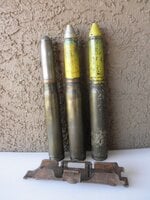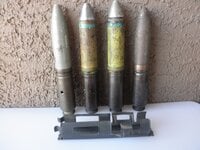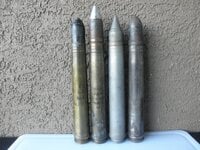Sort-of interesting thread, but I feel that the Germans covered all of this at the time!
Bf 109 armament was an issue from the start but, bearing in mind it's diminutive size, it was fairly well armed, and the 2x131 + 1x108 was a hard hitter that maintained fighter performance. The engine mounted cannon on the DB 605 was fitted to the engine in a recoil mount that bolted to the engine rear gearcase. This basic arrangement proved to be
suitable to the MK 108, with considerable modification, and which was shorter than the MG 151 but not much heavier. This was important, because virtually none of the larger guns could be accommodated so easily, or at all. The ability of the DB 605 to accept greater weight and recoil loads on the basic 4 bolt mounting would also seem to be an issue.
So, looking at bomber-killing weapons, the Germans recognised that the Fw 190 was a better bet and there are many versions to do that (with Bf 109 protection from escort fighters) .
They tried large cal weapons in the Me 410 but, it fell into the trap of needing strong escort as well (something that a 37mm cannon Bf 109 would have also suffered from) and the big cannon Me 410 is reported to have suffered difficulty with aiming accuracy, no good if you miss!
The real progress might have come with the Do 335 as a bomber killer, but I suppose that the WW2 ultimate was the Me 262 with 4x108, that did have real effect.
Eng
Bf 109 armament was an issue from the start but, bearing in mind it's diminutive size, it was fairly well armed, and the 2x131 + 1x108 was a hard hitter that maintained fighter performance. The engine mounted cannon on the DB 605 was fitted to the engine in a recoil mount that bolted to the engine rear gearcase. This basic arrangement proved to be
suitable to the MK 108, with considerable modification, and which was shorter than the MG 151 but not much heavier. This was important, because virtually none of the larger guns could be accommodated so easily, or at all. The ability of the DB 605 to accept greater weight and recoil loads on the basic 4 bolt mounting would also seem to be an issue.
So, looking at bomber-killing weapons, the Germans recognised that the Fw 190 was a better bet and there are many versions to do that (with Bf 109 protection from escort fighters) .
They tried large cal weapons in the Me 410 but, it fell into the trap of needing strong escort as well (something that a 37mm cannon Bf 109 would have also suffered from) and the big cannon Me 410 is reported to have suffered difficulty with aiming accuracy, no good if you miss!
The real progress might have come with the Do 335 as a bomber killer, but I suppose that the WW2 ultimate was the Me 262 with 4x108, that did have real effect.
Eng



